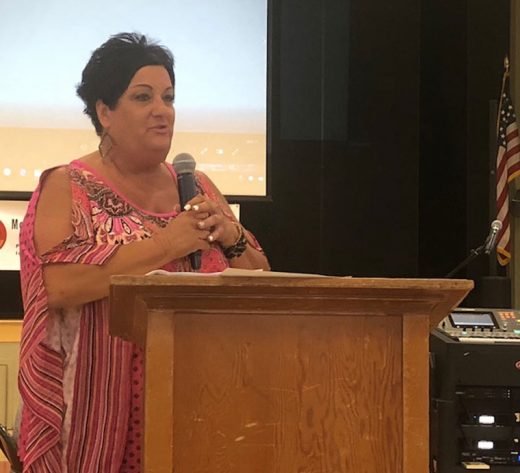
Photo by Melissa diaz hernandez
Highway 243, with traffic control, opens Nov. 1
At a town meeting Tuesday, Aug. 27, Caltrans Chief of Public and Media Affairs for District 8 Terri Kasinga announced that Highway 74, between Valle Vista and Mountain Center, would be open 24 hours a day with a pilot car beginning Friday, Aug. 30. Starting Nov. 1, Highway 243 will be open with some form of traffic control.
“Substantial completion is expected by late September or early October,” she told the crowd about Highway 74. “Most of the big work is done.”
The pilot cars are still needed as Ames Construction finishes the final work on the road. Guardrails, safety signage and striping remain to be completed.
“We’re working on guardrails, safety features and striping,” Amgad Benjamin, the resident Caltrans engineer for this area told the meeting’s attendees. “We will try to do most of the work off the road.”
By late September to early October, the road will be open with flagging operations during daytime work hours for smaller projects, according to Kasinga during the meeting.
In the spring, Caltrans will be concentrating on Highway 74 projects from Mountain Center to the desert, although a few projects between Mountain Center and Hemet will remain, according to Benjamin.
The surprising news was when Kasinga revealed to the crowd at Idyllwild School’s Gymnasium that Highway 243, between Idyllwild and Banning, will open Nov. 1 with some form of traffic control such as a pilot car or flagging.
Some of the work on Highway 243, including remaining culverts and embankment improvement to prevent erosion, will need permits, Benjamin added. However, that can be done with flagging operations so that residents “can get up and down to Banning.”
Repair costs
The repairs on Highway 74 are not solely needed because of the February 14 storm and winter rains. Last year’s Cranston Fire and summer monsoonal storms also caused damage to the highway. Only a portion of the needed repairs were completed before the winter and torrential storm.
Consequently, Caltrans has three separate projects or contracts being used to repair and restore the highway.
Phase 1 was emergency repairs. After the Cranston Fire, Caltrans identified about 90 culverts that were damaged and needed repair or replacement. The estimate to complete this work was $25 million.
After the winter storms, 50 more damaged culverts were identified, pushing the number to 140. This emergency contract was $29.8 million.
Regional Engineer Brian Hedman stated that the funding “only allows us to fix what breaks.” A redesign of the highways would not be permitted. Replacing culverts and restoring eroding embankments are examples of approved projects. It was stated several times throughout the meeting that Caltrans can only fix what is broken or about to break.
Nearly 30 culverts under both highways still need repair. Work on embankments along Highway 243 will also continue. Some of this work will require permits and complete repair or reconstruction may take another year, Kasinga added.
A third project impacting Highway 243 is a complete repaving from Banning to just before Lake Fulmor. This work has already started near Banning and will cost about $7.5 million. Caltrans hopes to complete the work before winter. If the repaving project is not completed, then the project will stop until spring brings warmer temperatures.
Caltrans estimates that the repair work for the projects to date has consumed 92,000 hours and required more than 16,700 tons of asphalt.
Confusion
A couple days after the meeting, the Caltrans press release and dialogue with one of Caltrans’ media contacts created confusion and possible fear that the information presented during Tuesday’s meeting was inaccurate.
The original press release sent out by Caltrans Maintenance Public Information Officer Shane Massoud to the media and published on Facebook the day after the meeting reads, “By late October 2019, Caltrans will change the escort access to a 24/7 flagging-operations.” At the Tuesday evening meeting, both Kasinga and Benjamin said the flagging operation would begin late September or early October. It was also stated during the meeting that the flagging operation would occur during daytime work hours.
Starting Friday, Aug. 30, Highway 74 will be open 24/7 with the pilot car and continue without interruption, unless an emergency occurs. However, the Town Crier received an email on Friday, Aug. 30 from Caltrans Public Information Officer Emily Leinan, who was responding to inquiries while Massoud was out of the office on vacation. The newspaper had originally sent an email to Massoud asking if the information in the press release was correct or an error was made. When the out of office notification was received, Leinan was contacted. She responded, “The 24/7 escorts are only for the holiday weekend, and that is all Terri [Kasinga] was referencing. After that, the escorts will go back to the scheduled time. Amgad [Benjamin] mentions after Terri [Kasinga], all the work that is required and needed to be done. The press release information is correct.”
The Town Crier immediately forwarded the response to Kasinga asking for clarification as this is not the information that was presented to the town Tuesday evening. Kasinga responded within minutes stating that the newspaper was correct and that the press release would be updated and sent out.










The pilot car route is frustratingly inefficient. The road is closed for 9.5 miles. The lower 3 miles have seen no construction in months and do not need to be closed or piloted. The upper 2.5 miles also have seen no construction in months and do not need to be closed or piloted. That leaves 4 miles in the middle that are still legitimately in need of attention. How much more efficient would the pilot car be if those of us who are required to follow the sluggish pilot car only had to do so for 4 miles. That leaves 4 miles in the middle that are still legitimately in need of attention. How much more efficient would the pilot car be if those of us who are required to follow the sluggish pilot car only had to do so for 4 miles? Has no one thought of this or noticed this? To me it is completely ridiculous and a colossal waste of resources and time. I’ve seen construction closures throughout the state and none are this bad, poorly run and in efficient.